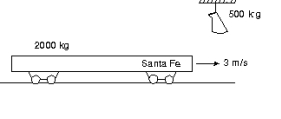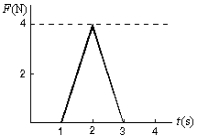A) on the rim
B) a distance R/2 from the center
C) a distance R/3 from the center
D) a distance 2R/3 from the center
E) at the center
G) A) and B)
Correct Answer

verified
Correct Answer
verified
Multiple Choice
A 500-kg sack of coal is dropped on a 2000-kg railroad flatcar which was initially moving at 3 m/s as shown. After the sack rests on the flatcar, the speed of the flatcar is: 
A) 0.6 m/s
B) 1.2 m/s
C) 1.8 m/s
D) 2.4 m/s
E) 3.6 m/s
G) A) and C)
Correct Answer

verified
Correct Answer
verified
Multiple Choice
A rifle of mass M is initially at rest but free to recoil. It fires a bullet of mass m and velocity v (relative to the ground) . After firing, the velocity of the rifle (relative to the ground) is:
A) -mv
B) -Mv/m
C) -mv/M
D) -v
E) mv/M
G) B) and C)
Correct Answer

verified
Correct Answer
verified
Multiple Choice
The velocity of the center of mass of a system of particles changes as v = 4.5 t + 2.4 t2 + 1.1 t3, where v is in meters per second. If the system starts from rest at t = 0, what is its acceleration at t = 3.0 s?
A) 7.1 m/s2
B) 14 m/s2
C) 20 m/s2
D) 49 m/s2
E) 65 m/s2
G) C) and D)
Correct Answer

verified
Correct Answer
verified
Multiple Choice
The velocity of the center of mass of a system of particles changes as v = 4.5 t + 2.4 t2 + 1.1 t3, where v is in meters per second. If the system starts from rest at t = 0, what is its position at t = 3.0 s?
A) 7.1 m
B) 21 m
C) 40 m
D) 49 m
E) 64 m
G) None of the above
Correct Answer

verified
Correct Answer
verified
Multiple Choice
When you step on the accelerator to increase the speed of your car, the force that accelerates the car is:
A) the force of your foot on the accelerator
B) the force of friction of the road on the tires
C) the force of the engine on the drive shaft
D) the normal force of the road on the tires
E) none of the above
G) All of the above
Correct Answer

verified
Correct Answer
verified
Multiple Choice
A 640-N hunter gets a rope around a 3200-N polar bear. They are stationary, 20 m apart, on frictionless level ice. When the hunter pulls the polar bear to him, the polar bear will move:
A) 1.0 m
B) 3.3 m
C) 10 m
D) 12 m
E) 17 m
G) D) and E)
Correct Answer

verified
Correct Answer
verified
Multiple Choice
Two spacemen are floating together with zero speed in a gravity-free region of space. The mass of spaceman A is 120 kg and that of spaceman B is 90 kg. Spaceman A pushes B away from him with B attaining a final speed of 0.5 m/s. The final recoil speed of A is:
A) 0 m/s
B) 0.38 m/s
C) 0.43 m/s
D) 0.50 m/s
E) 1.0 m/s
G) None of the above
Correct Answer

verified
Correct Answer
verified
Multiple Choice
Cart A, with a mass of 0.2 kg, travels on a horizontal air track at 3 m/s and hits cart B, which has a mass of 0.4 kg and is initially at rest. After the collision the center of mass of the two cart system has a speed in m/s of:
A) 0 m/s
B) 1.0 m/s
C) 2.3 m/s
D) 2.5 m/s
E) 5.0 m/s
G) A) and E)
Correct Answer

verified
Correct Answer
verified
Multiple Choice
A cart loaded with sand slides forward along a horizontal frictionless track. As the cart moves, sand trickles out at a constant rate through a hole in the back of the cart. The acceleration of the cart is:
A) constant and in the forward direction
B) constant and in the backward direction
C) variable and in the forward direction
D) variable and in the backward direction
E) zero
G) C) and D)
Correct Answer

verified
Correct Answer
verified
Multiple Choice
A golf ball of mass m is hit by a golf club so that the ball leaves the tee with speed v. The club is in contact with the ball for time T. The average force on the club on the ball during the time T is:
A) mvT
B) mv/T
C) (1/2) mv2T
D) mv2/(2T)
E) mT2/(2v)
G) None of the above
Correct Answer

verified
Correct Answer
verified
Multiple Choice
An elastic collision is one in which:
A) momentum is not conserved but kinetic energy is conserved
B) total mass is not conserved but momentum is conserved
C) kinetic energy and momentum are both conserved
D) momentum is conserved but kinetic energy is not conserved
E) the total impulse is equal to the change in kinetic energy
G) B) and D)
Correct Answer

verified
Correct Answer
verified
Multiple Choice
The center of mass of a system of particles remains at the same place if:
A) it is initially at rest and the external forces sum to zero
B) it is initially at rest and the internal forces sum to zero
C) the sum of the external forces is less than the maximum force of static friction
D) no friction acts internally
E) none of the above
G) B) and D)
Correct Answer

verified
Correct Answer
verified
Multiple Choice
Block A, with a mass of 2.0 kg, moves along the x axis with a velocity of 5.0 m/s in the positive x direction. It suffers an elastic collision with block B, initially at rest, and the blocks leave the collision along the x axis. If B is much more massive than A, the velocity of A after the collision is:
A) 0 m/s
B) +5.0 m/s
C) -5.0 m/s
D) +10 m/s
E) -10 m/s
G) A) and C)
Correct Answer

verified
Correct Answer
verified
Multiple Choice
A student's life was saved in an automobile accident because an airbag expanded in front of his head. If the car had not been equipped with an airbag, the windshield would have stopped the motion of his head in a much shorter time. Compared to the windshield, the airbag:
A) causes a much smaller change in momentum
B) exerts a much smaller impulse
C) causes a much smaller change in kinetic energy
D) exerts a much smaller force
E) does much more work
G) B) and D)
Correct Answer

verified
Correct Answer
verified
Multiple Choice
The law of conservation of momentum applies to a system of colliding objects only if:
A) there is no change in kinetic energy of the system
B) the coefficient of restitution is one
C) the coefficient of restitution is zero
D) the net external impulse is zero
E) the collisions are all elastic
G) B) and E)
Correct Answer

verified
Correct Answer
verified
Multiple Choice
The direction of the impulse on a struck baseball
A) depends on how fast the ball was thrown
B) is in the direction of the ball's change in velocity
C) is in the direction of the force of gravity
D) depends on how hard the ball is struck
E) Impulse is a scalar, and does not have a direction associated with it.
G) A) and C)
Correct Answer

verified
Correct Answer
verified
Multiple Choice
The force on a particle is given by F(t) = 0.71 t + 1.2 t2, in N. If the force acts from t = 0 to t = 2.0 s, the total impulse is:
A) 1.2 kg∙m/s
B) 1.9 kg∙m/s
C) 4.6 kg∙m/s
D) 4.8 kg∙m/s
E) 6.2 kg∙m/s
G) C) and D)
Correct Answer

verified
Correct Answer
verified
Multiple Choice
A 5-kg object can move along the x axis. It is subjected to a force in the positive x direction; a graph of F as a function of time t is shown below. Over the time the force is applied the change in the velocity of the object is: 
A) 0.8 m/s
B) 1.3 m/s
C) 1.6 m/s
D) 2.3 m/s
E) 4.0 m/s
G) C) and D)
Correct Answer

verified
Correct Answer
verified
Multiple Choice
At the same instant that a 0.50-kg ball is dropped from 25 m above Earth, a second ball, with a mass of 0.25 kg, is thrown straight upward from Earth's surface with an initial speed of 15 m/s. They move along nearby lines and pass without colliding. At the end of 2.0 s the velocity of the center of mass of the two-ball system is:
A) 11 m/s, down
B) 11 m/s, up
C) 15 m/s, down
D) 15 m/s, up
E) 20 m/s, down
G) A) and B)
Correct Answer

verified
Correct Answer
verified
Showing 41 - 60 of 99
Related Exams